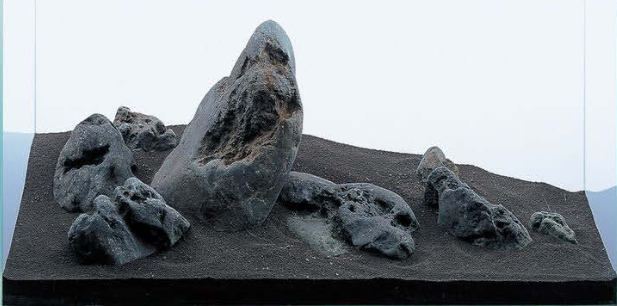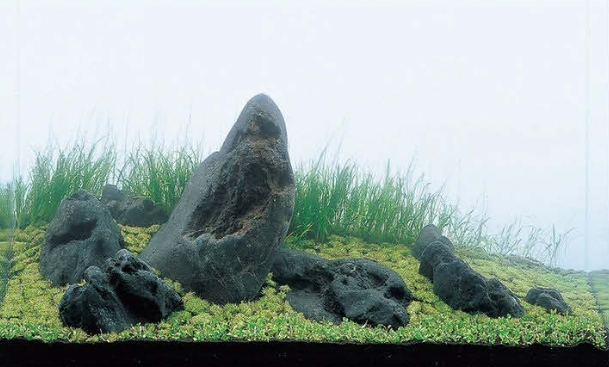Stones and driftwood are often used in an aquatic plant layout in addition to aquatic plants. Stones and driftwood are indispensable, especially for the Nature Aquarium, which recreates natural scenery in a layout. Since these layout materials are unaltered or slightly altered natural materials, you can render a natural feel to a layout by taking advantage of their shapes and texture.
For example, you can create an impression of a natural rock by placing a stone in the aquarium or an impression of a fallen tree by placing driftwood. The impression changes depending on the scale of natural scenery that you try to recreate. In an actual-sized layout, an impression of nature is created by using stones and driftwood just as they are. On the other hand, when recreating the grandeur of a natural landscape, stones will become mountains and driftwood will become trees.
Such large-scale natural scenery has become a new trend in recent years in the International Aquatic Plant Layout Contest as well. When it is taken to an extreme, it starts to look like a diorama model rather than an aquatic plant layout. An aquatic plant layout can create underwater scenery that can only be produced by an aquatic plant layout.
It is not my intention to repudiate diorama-like layouts, but 1 find a layout of underwater scenery more relaxing as I think about the comfort of fish or maintaining a layout. This may be because growing aquatic plants is easier in a layout of underwater scenery or because it does not feel unnatural to find fish swimming in it. In this article, 1 am going to introduce an iwagumi layout that recreates underwater scenery.




So, what types of stone bring up the image of underwater scenery? That would be natural river stones without a doubt. River stones are washed away by the force of water and become rounded with their edges ground down. River stones are characterized by rounded shapes that have been developed over a long period of time. Their shapes bring up an image of underwater scenery in a straightforward manner. However, the way the stones are arranged is important for taking advantage of this characteristic and creating underwater scenery. Stones in a river come to rest in the most stable positions and angles. Recreating this in an aquarium enables us to create a natural-looking underwater image with an impression of water flow.

Other stones were placed in such positions and orientations such that they do not contradict the water flow expressed by the oyasi. Lastly, the framework of the layout was completed by mounding the substrate so that the upstream appears higher and the downstream lower.
Subsequently, aquatic plants were planted by taking the flow of water into consideration. This type of aquascape appears more natural when taller plants are planted in the upstream direction and the space in the downstream area is left open. Glossostigma was planted in the foreground, Riccia was planted around rocks, and Echinodorus tenellus and Eleocharis vivipara were planted in the background in this layout. Eleocharis vivipara in the background was planted in such a manner that the planting became less dense toward the right-hand side and the background in the right end of the aquarium was left completely open. Such planting allowed the layout to appear natural against the flow of water expressed by the iwagumi arrangement.
For example, you can create an impression of a natural rock by placing a stone in the aquarium or an impression of a fallen tree by placing driftwood. The impression changes depending on the scale of natural scenery that you try to recreate. In an actual-sized layout, an impression of nature is created by using stones and driftwood just as they are. On the other hand, when recreating the grandeur of a natural landscape, stones will become mountains and driftwood will become trees.
Such large-scale natural scenery has become a new trend in recent years in the International Aquatic Plant Layout Contest as well. When it is taken to an extreme, it starts to look like a diorama model rather than an aquatic plant layout. An aquatic plant layout can create underwater scenery that can only be produced by an aquatic plant layout.
It is not my intention to repudiate diorama-like layouts, but 1 find a layout of underwater scenery more relaxing as I think about the comfort of fish or maintaining a layout. This may be because growing aquatic plants is easier in a layout of underwater scenery or because it does not feel unnatural to find fish swimming in it. In this article, 1 am going to introduce an iwagumi layout that recreates underwater scenery.
Recreating Underwater Scenery
There are many types of iwagumi layouts, such as one created in the image of a tall mountain, a strange rock formation, a bluff or reef, or a natural underwater scene in a river. Such images depend not only on the arrangement of stones, but also on the shape and texture of stones used in the layouts. For example, a ryuoh-sehi stone, which is shaped like eroded limestone, resembles the ridgeline of a mountain or an unusually-shaped rock. A manten-seki stone, which is shaped like a collapsed sedimentary rock, looks like a seaside bluff. Various types and shapes of stones conjure up different sceneries as described above and inspire us with various ideas for layouts.
Aquatic plants were planted to go with the direction of the water flow created by the stone arrangement. Aquatic plants are usually planted before the aquarium is filled with water
Water is added to the aquarium after planting is finished. The leaves of the aquatic plants, such as Eleocharis vivipara, should be straightened up with tweezers if they are tangled.
Although some of the stones will be somewhat hidden as the aquatic plants grow, this actually constitutes one of the techniques used to create a natural impression in a layout.
So, what types of stone bring up the image of underwater scenery? That would be natural river stones without a doubt. River stones are washed away by the force of water and become rounded with their edges ground down. River stones are characterized by rounded shapes that have been developed over a long period of time. Their shapes bring up an image of underwater scenery in a straightforward manner. However, the way the stones are arranged is important for taking advantage of this characteristic and creating underwater scenery. Stones in a river come to rest in the most stable positions and angles. Recreating this in an aquarium enables us to create a natural-looking underwater image with an impression of water flow.
Using Hakkai-Seki Stones
River stones called hakkai-sehi stones were used as layout materials in the layout introduced in this article. The largest stone, the oya ishi, was placed slightly toward the left in the center area, and smaller stones were placed on the left and right sides of the oyashio. The oya ishi was placed in an angle as if it had been pushed over by the flow of water. A smaller stone on the right was placed there to appear as though it is supporting the oyashio to keep it from falling over completely.Other stones were placed in such positions and orientations such that they do not contradict the water flow expressed by the oyasi. Lastly, the framework of the layout was completed by mounding the substrate so that the upstream appears higher and the downstream lower.
Subsequently, aquatic plants were planted by taking the flow of water into consideration. This type of aquascape appears more natural when taller plants are planted in the upstream direction and the space in the downstream area is left open. Glossostigma was planted in the foreground, Riccia was planted around rocks, and Echinodorus tenellus and Eleocharis vivipara were planted in the background in this layout. Eleocharis vivipara in the background was planted in such a manner that the planting became less dense toward the right-hand side and the background in the right end of the aquarium was left completely open. Such planting allowed the layout to appear natural against the flow of water expressed by the iwagumi arrangement.
